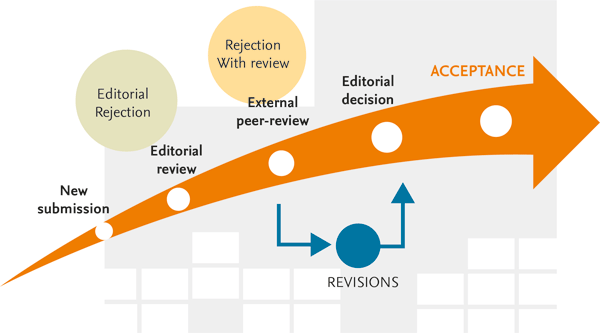
Image by master1305 on Freepik
Navigating the intricacies of the traditional journal publishing workflow can be particularly daunting for young researchers. There is a seemingly endless list of tasks and considerations to keep track of, which is overwhelming when struggling with new responsibilities and a pressure to publish. But fear not! In this article, we chart the journey of a manuscript from submission to final publication in a traditional journal publishing workflow, offering an overview of the academic publishing landscape.

Manuscript submission
The final step in the manuscript writing process and the first step in the journal publishing process is submitting your manuscript to your target journal. Before you take this final step, you must have done all the key language and technical checks to ensure your manuscript meets all the author and submission parameters laid down by your chosen journal to avoid desk rejection.
Before you submit, make sure you’ve ticked all the items off this submission checklist. Make sure:
- You submit the final version of your manuscript, saved under the right name and format.
- All your chapters are updated and finalized, with all tracked changes accepted.
- The tables, figures, and image files are correct and meet all the journal’s guidelines.
- Your manuscript includes all the metadata required with relevant keywords
- The author information is complete, with names and addresses for all authors and co-authors.
- You include all the ethical statements and permissions required and they are clearly labelled.
- Your Table of Contents is complete and updated; add any preliminary material (e.g., Contributors, Acknowledgements, Abbreviations, etc.).
- You have included any supplementary materials or biographical notes with your submission.
- You include a cover letter highlighting the research’s main theme, novelty, and relevance.
Refer to the online author resources that most journals provide and don’t hesitate to reach out to the journal if you have specific doubts about submitting your manuscript. Once these checks are done, submit your manuscript to your journal via their online submission systems, email or drop box (be sure to carefully check and follow journal instructions and preferred mode of submission).
Editorial desk screening
Once your manuscript is received by the journal, it is assessed and evaluated by the journal editorial team. At this stage of editorial review, your manuscript is checked to ensure it meets the basic journal requirements, including the cover letter, fit with journal aim and scope, appropriate length and format, quality of language, etc. This is a critical step in the traditional journal publishing workflow where a manuscript is either desk rejected without peer review or send forward for a peer review.
Desk rejection rates have been on the rise over the past few decades, this can go as high as 80% of the papers submissions at some journals.2 There are over 3 million manuscripts submitted to journals every year3 and editors have limited time to assess articles; this highlights how critical it is for authors to carefully follow the journal’s instructions about style, quality, and format to move ahead in the journal publishing workflow. Desk screening and rejection also has a few benefits. It saves reviewers’ time at the peer review stage and allows authors to move on and quickly submit their work to another journal.
Peer review process
If a manuscript passes the initial screening stage in the journal publishing workflow, it is sent to at least two peer reviewers for more detailed assessments. This part of the traditional journal publishing process is often the lengthiest, and reviewers can take anywhere between 2-6 months to complete their evaluation and ensure a scientific manuscript is experimentally and ethically sound. Journals reach out to their pool of peer reviewers to see if they’re willing to take up the review, while some journals have an option for authors to recommend their preferred and non-preferred reviewers (if this option is available, use it).
Once the reviewers are finalized, your article will be put through any one of the many different types of peer reviews. The most common types of peer review are single blind (reviewer names are not revealed to authors), double blind (review and author names are not revealed to each other), or open peer review (authors and reviewers know each other’s names). At this stage of the journal publishing workflow, peer reviewers assess the quality and appropriateness of the experimental design and research methods used. They also evaluate the significance and originality of the research and assess whether the work contributes to an advancement of knowledge in the field. Additionally, peer reviewers also watch for possible scientific errors in research and highlight citations that may be missing or incorrect.
After completing their evaluation, peer reviewers send a detailed report to the journal editor with their recommendations on whether the manuscript should be accepted or rejected.
Editorial assessment and approval
This stage in the journal publishing workflow involves the journal editor assessing and deciding the next steps based on the peer reviewers’ recommendations. The editor informs author/s of the next steps, so that they can respond to all the reviewers’ comments. The most common decisions are:4
- Acceptance without any changes: it is rare for a paper to be published in its original form.
- Acceptance with minor revisions: the journal requests some minor corrections before the paper is published; this is the most common decision.
- Acceptance after major revisions: the paper will be published based on the condition the author/s makes all the suggested changes.
- Revise and resubmit: the author/s are advised to make major changes in the manuscript and resubmit it to the journal for reconsideration.
- Rejection in final: the paper is rejected outright, and the journal will refuse to consider it even if the author/s make major revisions
In case of conflicting peer reviewer recommendations, the editor may seek feedback from other peer reviewers. Authors are kept informed of the decision and at this point of the journal publishing process can choose to submit their manuscript to another journal if they like – after making necessary revisions. It’s important to note that peer reviewers are meant to help authors enhance their manuscript for publication, however, it is the journal editor who makes the final decision on whether a manuscript should or shouldn’t be published.
Final editing and proofreading before publication
Once the manuscript is revised and sent back to the journal, it is checked and edited for basic grammar and language. The editorial team checks on the structure, format and layout of the article and page proofs are sent to the author for a final check. Detailed proofreading and edits are done to ensure that even minor mistakes are corrected. This is the last step in the journal publishing workflow after which the manuscript is considered ready for publication on either online platforms or in print formats that can be shared and accessed by the journal’s subscriber base. For journals who follow a more traditional journal publishing workflow, the article gets queued up for collation with other articles to be included in the next issue of the journal. Depending on the size of the journal’s backlog, the time taken to publication can range anywhere from a few weeks to several months.
References:
- Volunteer for Review – Journal for Proteomics. Guide for Authors, Elsevier. Available at https://www.journals.elsevier.com/journal-of-proteomics/news/volunteer-review-journal-of-proteomics
- Harzing, A-W. How to avoid a desk-reject in seven steps. Harzing.com, May 2020. Available at https://harzing.com/blog/2020/05/how-to-avoid-a-desk-reject-in-seven-steps
- Peer review in scientific publications, Vol 2. House of Commons Science and Technology Committee, London, UK, July 2011. Available at https://publications.parliament.uk/pa/cm201012/cmselect/cmsctech/856/856vw.pdf
- Submission & Peer Review. Author Resources, Wiley Author Services. Available at https://authorservices.wiley.com/author-resources/Journal-Authors/submission-peer-review/peer-review.html



